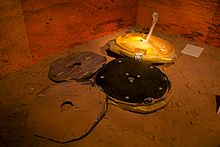Beagle 2
ESA, however, received no communication from the lander at its expected landing time on Mars, and declared the mission lost in February 2004 after numerous attempts to contact the spacecraft were made.
[6][7] The images showed it landed safely but two of its four solar panels failed to deploy, blocking the spacecraft's communications antenna.
[9] According to Pillinger: "HMS Beagle was the ship that took [Charles] Darwin on his voyage around the world in the 1830s and led to our knowledge about life on Earth making a real quantum leap.
"[10]A 50 by 8 kilometres (31.1 by 5.0 mi) ellipse centered on 11°32′N 90°30′E / 11.53°N 90.50°E / 11.53; 90.50 at Isidis Planitia, an enormous, flat, sedimentary basin that overlies the boundary between the ancient highlands and the northern plains of Mars, was chosen as the landing site.
The Beagle 2 lander's objectives were to characterise the landing site geology, mineralogy, geochemistry, and oxidation state of the physical properties of the atmosphere and surface layers; collect data on Martian meteorology and climate; and search for biosignatures.
[13] In an effort to publicise the project and gain financial support, its designers sought and received the endorsement and participation of British artists.
[17] The Beagle 2 lander was funded through a partnership arrangement involving the Open University, EADS-Astrium, the DTI, the Particle Physics and Astronomy Research Council (PPARC), the Office of Science and Technology and ESA.
PLUTO has a compressed spring mechanism that was designed to enable it to move across the surface at a rate of 20 mm per second and to burrow into the ground, collecting a subsurface sample in a cavity in its tip.
The lander's cover is hinged and folded open to reveal the craft's interior, which holds a UHF antenna, the 0.75 m (2.5 ft) long robotic arm, and the scientific equipment.
The main body also contains the battery, telecommunications, electronics, central processor, heaters, additional payload items, and radiation and oxidation sensors.
A panoramic image of the landing area was then supposed to be taken using the stereo camera and a pop-up mirror, after which the lander arm would have been released.
[23] It was claimed the blurry images showed the primary impact site as a dark patch and, a short distance away, Beagle 2 surrounded by the deflated airbags and with its solar panels extended.
[25] Pillinger speculated[26] higher than expected levels of dust in the Martian atmosphere, which captures heat, caused it to expand and reduce in density so the parachutes were not able to sufficiently slow the probe's descent.
[27] If the Martian atmosphere was thinner than expected, the parachute's effectiveness would be reduced and therefore cause the lander to hit the surface with enough speed to destroy it.
David Southwood, ESA's Director of Science, provided four scenarios of possible failures:[30] In addition, further scenarios appeared plausible and consistent with the available body of data: In February 2005, following comments from the House of Commons Select committee on science and technology, the report was made public and Leicester University independently published a detailed mission report, including possible failure modes and a "lessons learned".
On 16 January 2015, more than eleven years after its loss and eight months after Colin Pillinger died,[32] news sources confirmed NASA's Mars Reconnaissance Orbiter had located the lander,[6][7][33] which is lying on the surface of Isidis Planitia at 11°31′44″N 90°25′53″E / 11.52879°N 90.43139°E / 11.52879; 90.43139,[4][34][35] about 5 km (3.1 miles) from the planned centre of its landing zone.
[36] The technique called Super-Resolution Restoration (SRR) allows improvement in resolution by taking multiple views then intensively processing them.
[37] Imaging analysis appears to show the probe on the surface and partially deployed, in the expected landing area, with objects that have been interpreted as being its parachute and back cover nearby.
Images suggest one of the "petals" on which the solar panels of the lander are mounted failed to fully open, preventing deployment of its radio antenna and blocking communication.
[6][7][33][38] As the probe's antenna is beneath the last panel, it would have been unable to transmit or receive in such a configuration so the lander would have been beyond recovery even if its systems were still operational.
[5][41] A study has revealed Beagle 2 may have gone into its pre-programmed surface operations mode and collected data after landing but did not transmit it or the transmission was blocked by a closed panel.







 Clickable image:
Clicking on the labels will open a new article.
Clickable image:
Clicking on the labels will open a new article.


